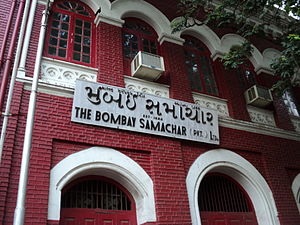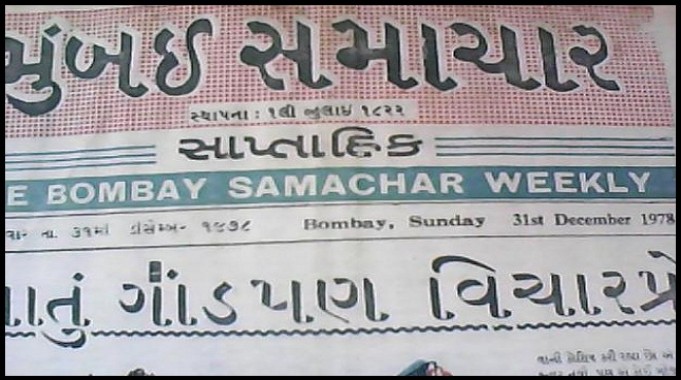Living legends: India’s oldest newspapers
Living legends-I
Asia's oldest continuously published newspaper, the Mumbai Samachar, a Gujarati language daily, celebrated 193 years of its event-filled existence on 1 July 2015. First published as the weekly Bombay Samachar in 1822, it comprised three small quarto sheets, 10 inches by 8 inches, and a half sheet supplement, in all containing 14 pages of printed matter.
It was published as a weekly till 1832, a bi-weekly till 1855 and a daily since then. It continued to grow and became one of western India's premier newspapers, read by a large segment of Gujarati-speaking people both in India and abroad.
It was founded by Fardoonji Murazban, a Parsi scholar and priest. Fardoonji was a pioneer not only of journalism in western India but of all Gujarati printed literature. He founded the first native press in 1812 and in 1814 brought out a Gujarati Calendar, six years before the first Bengali Calendar was printed and published in Calcutta.
Mumbai owes much to the Parsi community, including its print industry and newspapers. Although the first printing press was imported into Bombay as early as 1670 by the Parsi businessman Bhimjee Parikh, it was more than a hundred years before the first newspaper was printed. The first newspapers in Bombay were owned and printed by Parsis. The first English newspaper in Bombay was printed by Rustomji Keshaspathi in 1777.

By the end of the 18th century, the Parsi and Gujarati community dominated the commercial world of Mumbai in particular and entire western India in general. Mumbai emerged as a commercial hub, a distinction it retains to date. The Gujarati speaking people needed a newspaper in their language. At that time, the Calcutta Chronicle and the Indian Gazette were the leading newspapers. These papers had very little news about Mumbai. Fardoonji Murazban, a visionary, appreciated the need for local news and news in a vernacular language and consequently planned the publication of a Gujarati newspaper.
Bombay Samachar was published to disseminate need-based information, mostly to the trader community of Gujaratis and Parsis. News related to trade and business dominated. The content mix of the early issues of the paper reflects this. Its first issue had 14 pages. Its first page consisted of advertisements, two columns about things lost and one about the sale of some property, all relating to Parsis.
Then followed what could be called an article on "Ourselves", a kind of editorial. There were four columns of short paragraphs about Government and Court appointments and changes and powers of attorney taken from court sources; about the arrival and departure of ships and of Europeans from Mumbai; a list of European deaths; and the ships loading in the harbour.
Six columns were devoted to Kolkata news taken from the Indian Gazette and the Calcutta Chronicle; one column to Chennai news from the Government Gazette of that city; two columns to London news, whilst a short paragraph of ten lines was devoted to news from Canton in China, giving the prices of opium. Of local Bombay news there was very little, except the short paragraph about appointments.
There were several small advertisements of small traders and business men on the front page. This became a distinctive feature of this newspaper. To this day it follows the policy of allowing small advertisers to advertise their products on the front page rather than allow only one advertiser to occupy what is commonly referred to as the solus position.
Oldest newspapers still in circulation
|
Post och Inrikes Tidningar (Sweden) 1645 |
|
Haarlems Dagblad (Netherlands) 1656 |
|
La Gazzetta di Mantova (Italy) 1664 |
|
The London Gazette (UK) 1665 |
|
Wiener Zeitung (Austria) 1703 |
|
Hildesheimer Allgemeiner |
|
Worcester Journal (UK) 1709 |
|
Zeitung (Germany) 1705 |
|
The Newcastle Journal (UK) 1711 |
|
The Stamford Mercury (UK) 1712 |
|
The Northampton Mercury (UK) 1720 |
|
Hanauer Anzeiger (Germany) 1725 |
|
The Belfast News-Letter (N. Ireland) 1737 |
|
Feuille d'Avis de Neuchâtel (Switzerland) 1738 |
- Source: www.wan-press.org
From its inception, the editorial policy was to objectively report events in a fair and honest manner and not to sensationalize news. Sobriety and independence of views became a hall mark of Bombay Samachar. It was for this reason that the newspaper was respected by both British and Indian readers. The British administration also respected it for its balanced and objective stand. It created an identity for itself for its fair, frank, objective and critical analysis of events, which it retains even today. Its tag line, ‘Avval Dainik, Nishpaksh Dainik’ (Leading daily, non-partisan daily) sums up its policy.
Bombay Samachar played an important role during India's struggle for Independence. Its reports and editorials were often quoted by freedom fighters like Mahatma Gandhi, Jawaharlal Nehru, Vallabhbhai Patel and others and its pages included articles and letters by Gandhi and Patel.
For the first 80 years, the paper was owned and managed by Parsi priests. It has retained its connection with the Parsi community and culture even after the ownership changed. In fact, on Sundays, it still carries a column called 'Parsi Tari Arsi' which was started by Jehan Daruwalla who was the editor in the 1970s.
The ownership of Bombay Samachar passed through various hands before coming to rest in the Cama family, its present publishers, in 1933. To the good fortune of the paper, the Cama family nourished it with an eclectic mix of old and new. Though it has adopted new technology and a content mix to go with the times, much of its illustrious past has been preserved, especially by Hormusji N. Cama, the present director whose offices overlook the Horniman Circle Gardens, once regarded as the favourite social venue of the Parsis. The paper, interestingly still comes out from the same place where it was started.
By the new millennium Bombay (Mumbai) Samachar had become an iconic institution. So much so that Apollo Street in the Fort area was renamed after the paper as ‘Mumbai Samachar Marg’ in 2006.
By mid-2013, the Cama family published the daily Mumbai Samachar (a colour broadsheet plus a supplement; 16 pages of news and eight pages of features) and weekly (Sunday) and Diwali Ank, Panchang and Vasant Ank annually. Mumbai Samachar claims to have a circulation of over 1.8 million copies.
Dr Mrinal Chatterjee is professor and head of the Indian Institute of Mass Commuciations, Dhenkenal, Odisha mrinalchatterjeeiimc@gmail.com







